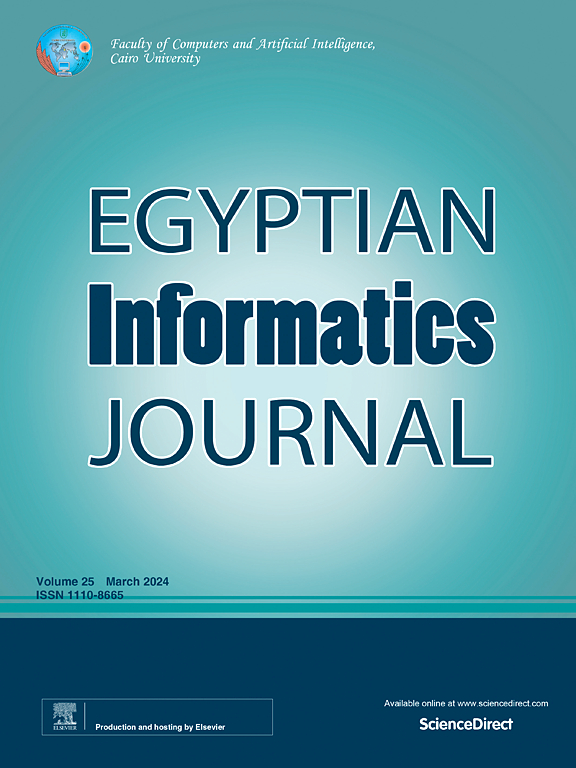Spectral analysis of Cupric oxide (CuO) and Graphene Oxide (GO) via machine learning techniques
IF 5
3区 计算机科学
Q1 COMPUTER SCIENCE, ARTIFICIAL INTELLIGENCE
引用次数: 0
Abstract
Chemical graph theory has recently gained much attraction among researchers due to its extensive use in mathematical chemistry. In this research article, We have studied the spectral properties such as eigenvalues, energy and Estrada index of some chemical structures such as Cupric oxide () and Graphene Oxide (GO). We have computed the energy and the other invariant Estrada index of the above mentioned graph structures and obtain the polynomial regression analysis using machine learning techniques. This approach permitted us to predict the spectral values more precisely and analyze the difference between the actual and predicted values. The actual values of energy and Estrada index is represented by and while the predicted values of energy and Estrada index is represented by and , where represents ”actual value” and represents ”predicted value”. We first use traditional method based on softwares and get the actual values () (see section 2). Then we perform machine learning techniques to generate a best fit model and get the predicted values () of the energies and Estrada index of Cupric oxide and Graphene Oxide by using the best fit second order polynomial for Energy and Estrada Index of is obtained as and , respectively. Similarly, the best fit second order polynomial for Energy and Estrada Index of is obtained as and , respectively. We have observed the difference between and which shows our machine learning model is best fit model as the error between the and is minimum.
利用机器学习技术对氧化铜(CuO)和氧化石墨烯(GO)进行光谱分析
化学图论由于其在数学化学中的广泛应用,近年来在研究人员中引起了很大的兴趣。本文研究了氧化铜(CuO)和氧化石墨烯(GO)等化学结构的特征值、能量和Estrada指数等光谱性质。我们计算了上述图结构的能量E(G)=∑i=0n|λi|和另一个不变Estrada指数EE(G)=∑i=1neλi,并利用机器学习技术获得了多项式回归分析。这种方法使我们能够更精确地预测光谱值,并分析实际值与预测值之间的差异。能量和Estrada指数的实际值用Eav和EEav表示,能量和Estrada指数的预测值用Epv和EEpv表示,其中av代表“实际值”,pv代表“预测值”。我们首先使用传统方法基于软件和实际值(av)(见第二节)。然后我们执行机器学习技术来生成最适合模型并得到预测值(pv)的能量和埃斯特拉达指数氧化铜措和氧化石墨烯通过使用最适合的二阶多项式对能源和埃斯特拉达措获得指数E(错)=−0.007 m2 + 5.892 mn + 2.243 + 2.169 n−0.365和EE(错)= 0.537 + 2.084米+ 2.084 n + 13.533 mn,分别。同样,GO的Energy和Estrada Index的最佳拟合二阶多项式分别为E(GO)= - 0.266+2.533m+2.598n+0.014m2+3.133mn+ - 0.017n2和EE(GO)= - 1.671+4.400m+4.440n+0.016m2+6.553mn+0.014n2。我们已经观察到av和pv之间的差异,这表明我们的机器学习模型是最佳拟合模型,因为av和pv之间的误差最小。
本文章由计算机程序翻译,如有差异,请以英文原文为准。
求助全文
约1分钟内获得全文
求助全文
来源期刊

Egyptian Informatics Journal
Decision Sciences-Management Science and Operations Research
CiteScore
11.10
自引率
1.90%
发文量
59
审稿时长
110 days
期刊介绍:
The Egyptian Informatics Journal is published by the Faculty of Computers and Artificial Intelligence, Cairo University. This Journal provides a forum for the state-of-the-art research and development in the fields of computing, including computer sciences, information technologies, information systems, operations research and decision support. Innovative and not-previously-published work in subjects covered by the Journal is encouraged to be submitted, whether from academic, research or commercial sources.
 求助内容:
求助内容: 应助结果提醒方式:
应助结果提醒方式:


